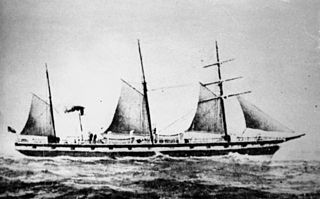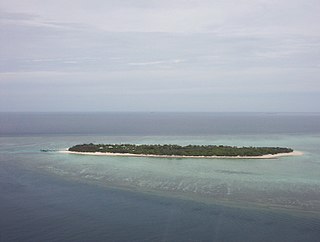Notes
- ↑ "Vessels in Harbour". South Australian Register, Wednesday 12 June 1850, p.2. Retrieved 11 January 2012.
- ↑ "The Wrecks in Torres' Straits". The Sydney Morning Herald, Saturday 9 September 1854, p.4. Retrieved 11 January 2012.
| History | |
|---|---|
| Name | Fatima |
| Builder | R. Hutchinson, Sunderland, England |
| Launched | 1849 |
| Fate | Wrecked upon Great Detached Reef on 26 June 1854. |
| General characteristics | |
| Class and type | Barque |
| Tons burthen | 521 tons |
| Length | 112 feet (34 m) |
| Beam | 26 feet (7.9 m) |
| Draught | 19 feet (5.8 m) |
Fatima was an English barque that was wrecked on 26 June 1854 in the Torres Strait. She was built by R. Hutchinson, Sunderland, Tyne and Wear, launched in 1849 and registered at Liverpool. Her cargo capacity was 521 tons burthen.
She sailed from London, England on 17 January 1850, under the command of Captain Ray, arriving at Port Adelaide, Australia on 11 June. [1]
Under the command of Captain W. Hardie, on a voyage from Melbourne to Batavia, she struck the Great Detached Reef and was wrecked on 26 June 1854. [2] The crew were rescued by the Bato off Raine Island.
Amongst the passengers on the outward voyage from London to Melbourne were Edward Thomas Fysh and his sister Harriet Fysh. Harriet married William Henderson Hardie in Melbourne and was on board the Fatima when the vessel was wrecked on Great Detached Reef. Harriet Fysh was grand aunt to Wilmot Hudson Fysh, pioneer aviator and co-founder of Qantas.

Marco Polo was a three-masted wooden clipper ship, launched in 1851 at Saint John, New Brunswick. She was named after Venetian traveler Marco Polo. The ship carried emigrants and passengers to Australia and was the first vessel to make the round trip from Liverpool in under six months. Later in her career, the ship was used as a cargo ship before running aground off Cavendish, Prince Edward Island, in 1883.
Sir Charles Hardy Islands is in the reef of the same name adjacent to Pollard Channel & Blackwood Channel about 40 km east of Cape Grenville off Cape York Peninsula.
Neva was a three-masted barque launched in 1813. She made two voyages transporting convicts to Australia. On her second voyage carrying convicts she wrecked in Bass Strait on 13 May 1835. Her loss was one of the worst shipwrecks in Australian history; 224 people died.

SS Gothenburg was an iron-hulled sail- and steamship that was built in England in 1854 and sailed between England and Sweden until 1862. She then moved to Australia, where she operated across the Tasman Sea to and from New Zealand until 1873, when she was rebuilt. After her rebuild, she operated in the Australian coastal trade.

Elizabeth Reef, located at 29°57′25″S159°4′32″E, is a coral reef in the Coral Sea. The reef is separated by a deep oceanic pass, some 47 km wide, from nearby Middleton Reef, both of which are part of the underwater plateau known as the Lord Howe Rise. It is around 150 km from Lord Howe Island and 600 km from the New South Wales coast of Australia. The Environment, Sport and Territories Legislation Amendment Act 1997 included Elizabeth Reef in Australia's Coral Sea Islands Territory.

Kenn Reef is a submerged coral atoll off the Pacific coast of Queensland, Australia. It is about 15 by 8 km and appears as either a backward facing "L" or a boot. The reef covers an area of approximately 40 km2, with an islet in the Southeast part of the reef called Observatory Cay which is approximately 2 m above the high tide level

The islands and reefs of the Capricorn and Bunker Group are situated astride the Tropic of Capricorn at the southern end of the Great Barrier Reef, approximately 80 kilometres east of Gladstone, which is situated on the central coast of the Gladstone Region, Queensland, Australia.
Wreck Island is a small coral cay. It is located near the Tropic of Capricorn in the southern Great Barrier Reef, 93 km due north east of Gladstone, Queensland, Australia, and 460 km north of the state capital Brisbane.

HMS Porpoise was a 12-gun sloop-of-war originally built in Bilbao, Spain, as the packet ship Infanta Amelia. On 6 August 1799 HMS Argo captured her off the coast of Portugal. Porpoise wrecked in 1803 on the North coast of what was then part of the Colony of New South Wales, now called Wreck Reefs, off the coast of Queensland, Australia.

HMS Herald was an Atholl-class 28-gun sixth-rate corvette of the Royal Navy. She was launched in 1822 as HMS Termagant, commissioned in 1824 as HMS Herald and converted to a survey ship in 1845. After serving as a chapel ship from 1861, she was sold for breaking in 1862.
Sun was a brig built in 1819 at Sunderland and was condemned at the Cape of Good Hope in August 1822. She was repaired and began sailing east of the Cape. She was wrecked in May 1826 in the Torres Strait.
Rolla was a sailing ship built in 1800 at South Shields, England. She made one voyage transporting convicts to New South Wales. She then made a voyage for the British East India Company from China back to Britain. She leaves Lloyd's Register in 1858.
Marchioness was a brigantine built at Waterford, Ireland in 1851 and registered at Melbourne that sailed between Nelson, New Zealand and Melbourne, Australia in the 1850s. It foundered on rocks off the Taranaki coast in 1864 and was lost with no loss of life, having previously grounded twice, once off the coast of Victoria, Australia, and once in Cook Strait.

Iserbrook was a general cargo and passenger brig built in 1853 at Hamburg (Germany) for Joh. Ces. Godeffroy & Sohn. It spent over twenty years as an immigrant and general cargo vessel, transporting passengers from Hamburg to South Africa, Australia and Chile, as well as servicing its owner's business in the Pacific. Later on, the vessel came into Australian possession and continued sailing for the Pacific trade. In 1878 it caught fire and was sunk the same year. At last, it was re-floated and used as a transport barge and hulk in Sydney until it sank again and finally was blown up.
Henry was a sailing ship built in 1819 at Quebec, Canada. She initially sailed between London and Quebec, but then she made two voyages transporting convicts from England to Australia. She was wrecked in the Torres Strait in 1825.
Claudine was launched at Calcutta in 1811. She made two voyages transporting convicts, one to Van Diemen's Land in 1821 and one to New South Wales in 1829. In between, she made one voyage under charter to the British East India Company (EIC). Her captain deliberately grounded her in November 1840 to survive a storm, but she was able to return to service. She was broken up in 1849.

The New Zealand Company was a 19th-century English company that played a key role in the colonisation of New Zealand. The company was formed to carry out the principles of systematic colonisation devised by Edward Gibbon Wakefield, who envisaged the creation of a new-model English society in the southern hemisphere. Under Wakefield's model, the colony would attract capitalists who would then have a ready supply of labour—migrant labourers who could not initially afford to be property owners, but who would have the expectation of one day buying land with their savings.

The SS Schomberg was a clipper built in Aberdeen by Alexander Hall & Co. for "the Black Ball line" for carrying large cargoes and steerage passengers, and to "outdo the Americans". When built, she was regarded as the most luxurious and well-built clipper of the period.

Charles Eaton was a barque, launched in 1833 for use as a merchant ship. Whilst under the command of Captain Fowle, she was wrecked in 1834 among the Torres Strait Islands, off the northern coast of Queensland, Australia, and her passengers and crew attacked and nearly all killed by Torres Strait Islanders on Mer Island. A cabin boy and small child survived and lived with the islanders until being rescued by Captain Lewis and crew on Isabella in June 1836, who also found skulls of some of the murdered people on a nearby island and took them back to Sydney for burial.